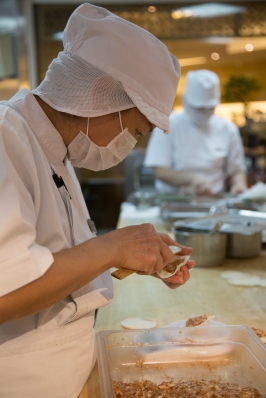Incredibly, luck had it that the haze cleared up starting from the moment I stepped off the plane. The gods must have been looking out for the wedding ceremonies just a few days away, but I as the beneficiary tourist certainly was relieved to see the sky again by Tuesday.

The country is compact enough to be a city, and its density, second-highest in the world, makes it feel similar to NYC or Chicago. One key difference: there are much fewer Americans in Singapore than in Chicago or NYC. Observing the city as a visitor in the few days I had, I was impressed by a few things: the food, the mass transit, the number of sights (for such a small region), the planning, and the diversity.
Oh, the food. My upbringing has always had an East Asian culinary element, so with an estimated over 70% of the population of Chinese descent, there was no problem finding familiar and good food in Singapore. (Even less so during the wedding, where nearly every event — and sometimes there were more than three in a day — was catered with delicacies and staples from the entire continent.) Xiao Long Bao, little pouches of steamed juicy goodness originally from Shanghai, are rather prevalent in Singapore. In doing some reading on them, I might have missed some good alternatives to where I went, but the 40 min wait was worth it. Once. Next time I’ll be more judicious with my time.
Hawker food centers are pretty well documented so I decided not to describe them here, but in addition to selling amazing food, the Tekka Centre Market also has several more rows of fresh produce and meats and seafood behind the normal food stalls. Some of these vegetables are difficult to find in standard American grocery stores, and coming from Germany, where nearly every vegetable (except those in salads) is either a potato or a carrot, this made me even more giddy to be gastronomically “home.” Unfortunately, my hotel had no kitchenette so the fragrant prepared food in the stalls next door would have to suffice in place of the appetizing uncooked stuff.
But there was something a bit biting about the hawker food centers: it seemed like the people who cleared the tables were barely scraping by. I didn’t want to ask the service staff about this as it’s a rather personal issue, but whether it was hawker food or food centers, there were always people clearing the tables who looked like they were shadows of a better life. Before I could get a shot, I got shooed away by one person whose facial expression showed this clearly, but my intention remains with the photo I did get even if the execution is lacking: I’m not sure how good of a living the service workers (and even perhaps some of the cooks) have. In a country that’s a powerhouse financial center and that sets the standard for efficiency, is a lower-class citizen a requirement for the gears to keep turning?
And this brought me to an interesting discussion with a native. Singapore seems immensely diverse demographically, and riding the MRT or simply walking around shows this rather readily. I was impressed, however, that I didn’t feel like I was transferring between regions; somehow, the place still felt homogeneous, like it had a national identity rather than individual identities of its factions. English is spoken by most people, leaving a common thread of language (important for establishing a culture), and people in general seemed to get along well. There was no unpleasant evidence of racial segregation.
It was pointed out at this point that a lot of Singapore was planned: there is a section where many people of Indian descent live (and where most Indian shops are), and the same is true for the Chinese. This local congregation is accepted in many cities, but what was peculiar was how calculated this division was in Singapore. Only being there for a week, I didn’t understand the history or politics behind the discussion, but visiting the Singapore URA‘s City Gallery, some of the undertones were a bit more apparent. The city is growing extremely quickly and to support the growth, the URA set up various exhibits to show both the significance of and plans to continue develop available land and resources. The message: in order to keep thriving, deliberate decisions must be taken now to ensure the future standard of living of its inhabitants. But does this mean calculated diversity? Is such a method wrong if there is peace and prosperity and good health?
Nevertheless, not all elements of city planning are so weighty, and the city itself welcomes the casual visitor to think of lesser issues. A friend who visited a few years ago commented that there are outdoor “gyms” in Singapore. During my Southern Ridges walk, which offers views to the Singapore Strait and a glimpse of how that area would be developed, I stumbled across one such park that was apparently just built a few months ago. Away from the social implications of demographics and after a cooling rain shower, this was the perfect area to unwind and take in the unique city-state at the very tip of Southeast Asia.
This post was not meant to criticize Singapore or its urban development. In fact quite the opposite. The orderly, meticulous planner in me didn’t notice the polite segregation until it was pointed out to me — which is as much an indictment of my value system as it was a catalyst in the discussion of Singapore diversity.






